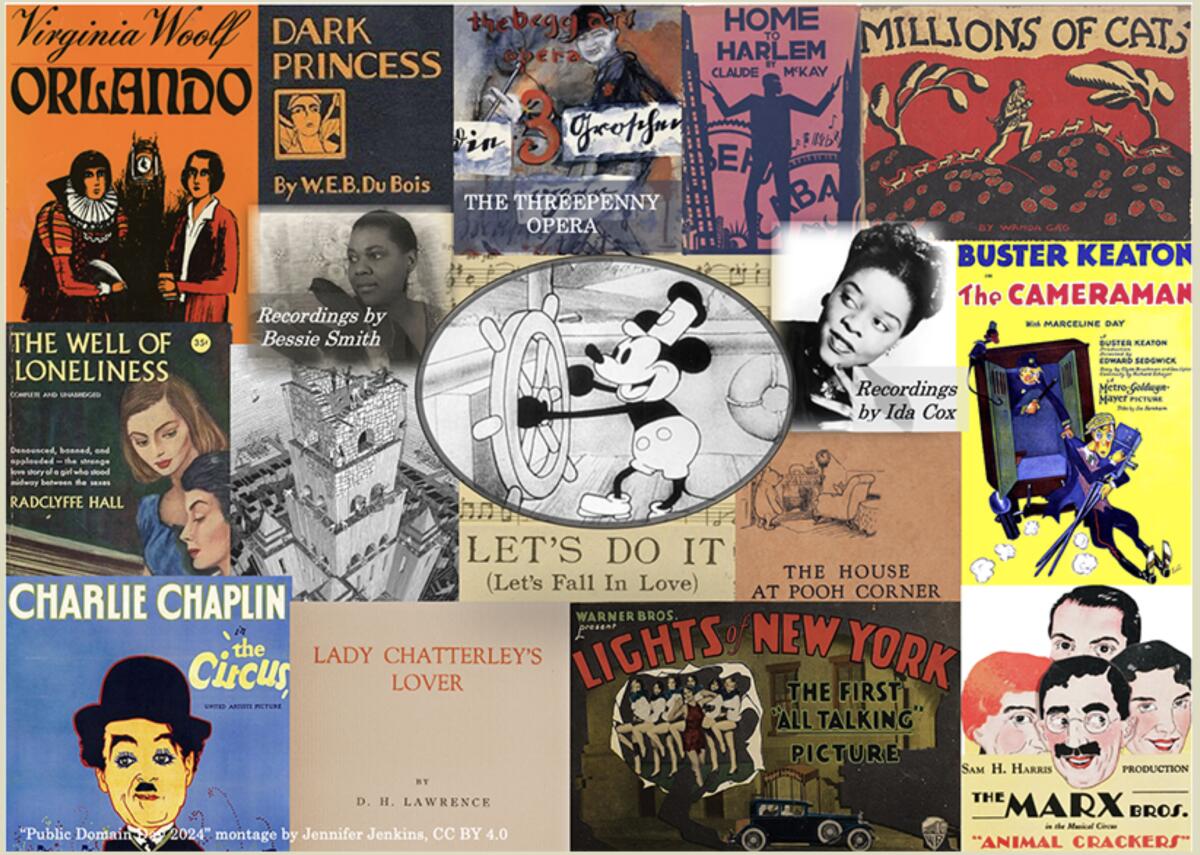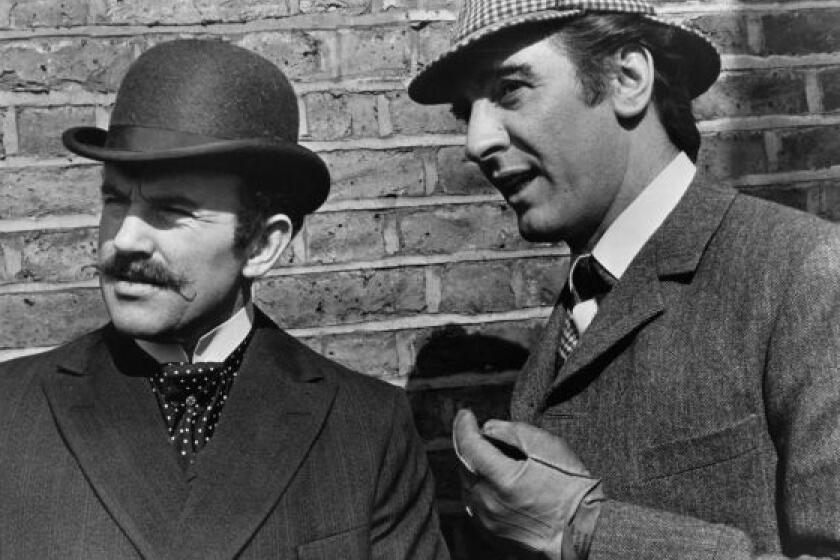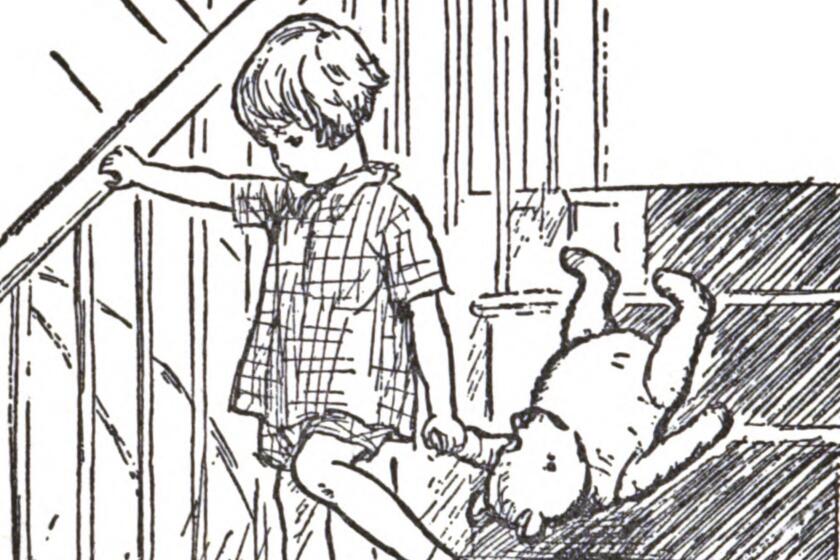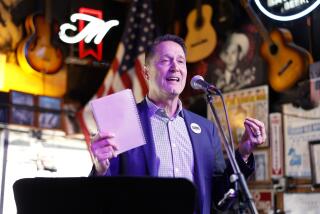Column: Mickey Mouse and ‘Lady Chatterley’s Lover’ enter the public domain on Jan. 1, a reminder of our crazy copyright laws

- Share via
It might be unusual to find Mickey Mouse and “Lady Chatterley’s Lover” mentioned in the same breath. But you can chalk up their momentary fellowship to America’s copyright laws, under which both are entering the public domain on Jan. 1.
That’s because both Mickey and Mellors, the Chatterley estate gamekeeper, made their first published appearance in 1928. The applicable law afforded them copyright protection for 95 years, a term expiring with the arrival of 2024.
Thousands of other works — literary, dramatic and musical — are entering the copyright-free period of their lives, according to the annual select list compiled by Jennifer Jenkins, director of Duke University’s Center for the Study of the Public Domain.
There are books that were banned for obscenity, a critique of the inhumanity of capitalist society, works from the Harlem Renaissance and a reminder of the lingering trauma from World War I.
— Jennifer Jenkins, Duke University
Among the new entrants are Bertolt Brecht’s “The Threepenny Opera,” Virginia Woolf’s “Orlando” and W.E.B. Du Bois’ “Dark Princess.” Also Evelyn Waugh’s first published novel, “Decline and Fall,” and A.A. Milne’s “House at Pooh Corner,” which introduced the character of Tigger. (A full list of works shedding their copyright protections on New Year’s Day can be found at the government’s Catalogue of Copyright Entries.)
Get the latest from Michael Hiltzik
Commentary on economics and more from a Pulitzer Prize winner.
You may occasionally receive promotional content from the Los Angeles Times.
All this will inspire new rounds of creativity, as artists acquire the unrestricted right to incorporate elements of previous works in their own creations and publishers gain the right to distribute older works more broadly. The economics favor the transition to the public domain — the expiration of copyright has virtually no effect on the income of creators of these works or their incentive to create, but it does help to inspire future creators.
Jenkins points to an explosion of creative glosses on “The Great Gatsby” after Fitzgerald’s novel entered the public domain in 2021: “New works such as Michael Farris Smith’s prequel ‘Nick,’ which tells the backstory of Nick Carraway, ‘Self-Made Boys,’ a young-adult ‘Great Gatsby remix’ centering on trans love, ‘The Gay Gatsby’ and ‘The Great Gatsby Undead’ (the zombie edition).”
As is the case every year, the list offers “a snapshot of the cultural struggles of the time, some of which seem decidedly relevant today,” Jenkins observes. “There are books that were banned for obscenity, a critique of the inhumanity of capitalist society, works from the Harlem Renaissance and a reminder of the lingering trauma from World War I.”
Woolf’s “Orlando” and Radcliffe Hall’s “The Well of Loneliness” explore issues of sexuality and gender that are still with us — arguably more than ever — 95 years on.
Some films entering the public domain are indelible classics: Buster Keaton’s “The Cameraman,” Charlie Chaplin’s “The Circus” and Carl Dreyer’s “The Passion of Joan of Arc” are among them.
One peculiarity of American copyright law is the distinct terms for musical compositions and musical recordings. In the former case, compositions created in 1928 are entering the public domain. These include “Mack the Knife” (Brecht and Kurt Weill, from “The Threepenny Opera”), “Sonny Boy” (made famous by Al Jolson) and “I Wanna Be Loved by You” (Bert Kalmar, Herbert Stothart and Harry Ruby, made famous by Marilyn Monroe’s unforgettable rendition in Billy Wilder’s “Some Like it Hot.”)
AI investors say their work is so important that they should be able to trample copyright law on their pathway to riches. Here’s why you shouldn’t believe them.
A copyright law revision in 2018 made recordings from 1923 subject to the public domain in 2024. Among them are original recordings of “Charleston” (James P. Johnson), “Yes! We Have No Bananas” (Eddie Cantor and the Sam Lanin Orchestra) and Paul Whiteman’s version of that all-time earworm, “Parade of the Wooden Soldiers.” As Jenkins cautions, only those specific recordings are freed from copyright; later versions of the same songs might still be protected.
Over the centuries, Congress has repeatedly revised copyright law, producing a labyrinthine code difficult even for experts to navigate on behalf of anyone hoping to use creative works. Key revisions tend to lengthen the copyright term, the lawmakers having the mistaken impression that longer terms benefit creators as well as society.
The initial copyright act, passed in 1790, provided for a term of 28 years including a 14-year renewal. In 1909, that was extended to 56 years including a 28-year renewal.
In 1976, the term was changed to the creator’s life plus 50 years. In 1998, Congress passed the Copyright Term Extension Act, which is known as the Sonny Bono Act after its chief promoter on Capitol Hill. That law extended the basic term to life plus 70 years; works for hire (in which a third party owns the rights to a creative work), pseudonymous and anonymous works were protected for 95 years from first publication or 120 years from creation, whichever is shorter.
Along the way, Congress extended copyright protection from written works to movies, recordings, performances and ultimately to almost all works, both published and unpublished.
The fundamental error in this timeline is the notion that ever-longer protection is a good thing. It’s wrong on several counts. To some extent it’s based on the theory that creators (or their heirs) should be entitled to income from a work well into the distant future in order to incentivize creative artists to create.
But the truth is that the income stream from all but a tiny minority of published works largely evaporates after the first few years, and what does arrive decades in the future has a minuscule present value at the time of creation. The 20-year extension in the 1998 law, as 17 economists (including five Nobel laureates) wrote in a 2002 Supreme Court brief, provided “no significant incentive to create new works” and arguably less for existing works.
In fact, constraining entry into the public domain is a drag on creativity.
The cherished works from 1927 losing their copyright protection include the film ‘Metropolis,’ a classic Laurel and Hardy short and the first Hardy Boys book.
Once a work enters the public domain, Jenkins says, “community theaters can screen the films. Youth orchestras can perform the music publicly, without paying licensing fees. Online repositories such as the Internet Archive, HathiTrust, Google Books, and the New York Public Library can make works fully available online. This helps enable access to cultural materials that might otherwise be lost to history. ... Anyone can rescue them from obscurity and make them available, where we can all discover, enjoy, and breathe new life into them.”
In some cases, extended copyright seems to work against the public interest. Consider the stringent control exercised by the estate of the Rev. Martin Luther King Jr. — mostly his children — over his speeches and writings such as the “I Have a Dream” speech he delivered in Washington, D.C., on Aug. 28, 1963.
On the day it was delivered, the speech was eligible for copyright protection through 2019. Congressional revisions extended the speech’s copyright until 2058, nearly a century after King delivered it to a massive crowd at the Lincoln Memorial and untold more viewers on television. Filmmaker Ava DuVernay had to put rewritten and paraphrased lines into the mouth of the actor portraying King in her film “Selma,” about the 1965 protests in support of the Voting Rights Act.
DuVernay’s options were limited because the King estate had sold the film rights to Steven Spielberg for a still-unproduced project. Even had she acquired the rights, she said, that might have required giving the family a voice in how King was portrayed, constraining her own artistic choices.
As I observed a year ago, if it was vanishingly unlikely that the posthumous 95-year term in the Sonny Bono Act would be an incentive to any living artist or writer, it was a boon for the Walt Disney Co.
At the time, Disney was facing the expiration of rights to the earliest films featuring Mickey Mouse and the looming cutoff of the royalty spigot, so it placed its considerable political and financial weight behind the extension and got what it wanted.
The irony of the term extension is that Disney, which pushed so hard to keep its own creations out of the public domain, is perhaps our most assiduous exploiter of, yes, the public domain.
‘Winnie-the-Pooh,’ ‘The Sun Also Rises’ and many other works entered the public domain on Saturday. They show what’s wrong with the system.
The core material of some of its most successful and profitable movies comes from Hans Christian Andersen, Shakespeare, Lewis Carroll and Charles Perrault — often freely reimagined and rewritten by Disney artists and writers.
Disney’s “Fantasia” mined musical history for compositions by Bach and Beethoven, but if the copyright terms Disney pushed for in 1998 were in place when the film was made in 1940, the compositions used in the film by Ponchielli, Dukas, Tchaikovsky and Mussorgsky would still be under copyright protection. Disney did license “The Rite of Spring” from Igor Stravinsky—for $6,000—because it was then still under copyright overseas. But if Disney had to pay licensing fees to those other composers, the film probably could not have been made.
That brings us back to Mickey. The work entering the public domain is “Steamboat Willie,” the Disney short in which he made his first public appearance. It’s proper to note that only the version of Mickey in that film is making the transition to the public domain. Features added to the mouse in his long evolution are still copyrighted. Those include his white gloves (added in 1929) and possibly some artifacts of colorized versions, such as his red shorts. Creators using Mickey Mouse may be well advised to stick with the ur-Mickey in “Steamboat Willie.”
Another caution involves Disney’s ownership of Mickey as a trademark. Any use of Mickey that might confuse consumers into thinking it’s endorsed or produced by Disney is a violation. Trademarks don’t automatically expire.
In other words, celebrate the liberation of Mickey Mouse into the public domain if you wish. But remember that the issue of creative rights remains a minefield and, unfortunately, Congress has done nothing to make it safe.
More to Read
Get the latest from Michael Hiltzik
Commentary on economics and more from a Pulitzer Prize winner.
You may occasionally receive promotional content from the Los Angeles Times.













